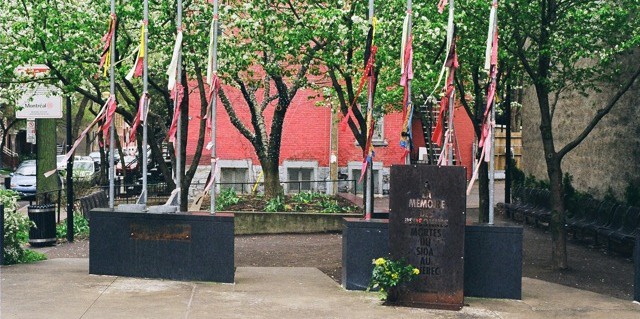
|
Montreal, QC Canada |
rues Sainte-Catherine et Panet, coin sud-ouest | Park of Hope |
since 1 December 1991 without names |
On December 1st, 1991, Act UP Montreal ended its World AIDS Day demonstration in an empty lot in the heart of the district inhabited by the persons most affected by the AIDS epidemic in Montreal: gay men, IV drug users, hemophiliacs, women, children, sex workers. The activists hung 1 200 black ribbons in the trees, dramatically underlining the number of AIDS deaths in Quebec. The City of Montreal removed the ribbons immediately.
In January 1992, Act Up redecorated the trees with 1 200 multicolored ribbons. Then, the community joined in. For many years, the trees were full of memorial ribbons with the names of the dead on them; teddy-bears and personal objects were placed beneath the trees. The movement to create a cenotaph was born.
A grass-roots campaign got under way and Neighborhood Committees were petitioned about the need for a cenotaph dedicated to those who had died of AIDS. In May 1992, as a kind of appropriation, a non-official sign, “Park in memory of the lives of those who have died of AIDS in Quebec”, was installed at the site by Act Up.
At the Montreal City Council, the counselors hesitated to name a park after a disease but after a long struggle led by Act Up, in September 1994, the park was finally officially designated as “Parc de l’Espoir” (Park of Hope) and a commemorative plaque was installed.
In 1997, the City of Montreal redeveloped the park as a cenotaph to commemorate the lives of all the persons who died in this epidemic so they could bear witness to the indifference of our governments as well as the danger represented by this virus.
The front section of the park represents death, symbolized by black granite blocks and concrete. The garden in the rear of the park reflects life.
La Mémoire vivante du Parc de l'Espoir
In January 1992, Act Up redecorated the trees with 1 200 multicolored ribbons. Then, the community joined in. For many years, the trees were full of memorial ribbons with the names of the dead on them; teddy-bears and personal objects were placed beneath the trees. The movement to create a cenotaph was born.
A grass-roots campaign got under way and Neighborhood Committees were petitioned about the need for a cenotaph dedicated to those who had died of AIDS. In May 1992, as a kind of appropriation, a non-official sign, “Park in memory of the lives of those who have died of AIDS in Quebec”, was installed at the site by Act Up.
At the Montreal City Council, the counselors hesitated to name a park after a disease but after a long struggle led by Act Up, in September 1994, the park was finally officially designated as “Parc de l’Espoir” (Park of Hope) and a commemorative plaque was installed.
In 1997, the City of Montreal redeveloped the park as a cenotaph to commemorate the lives of all the persons who died in this epidemic so they could bear witness to the indifference of our governments as well as the danger represented by this virus.
The front section of the park represents death, symbolized by black granite blocks and concrete. The garden in the rear of the park reflects life.
La Mémoire vivante du Parc de l'Espoir
















































